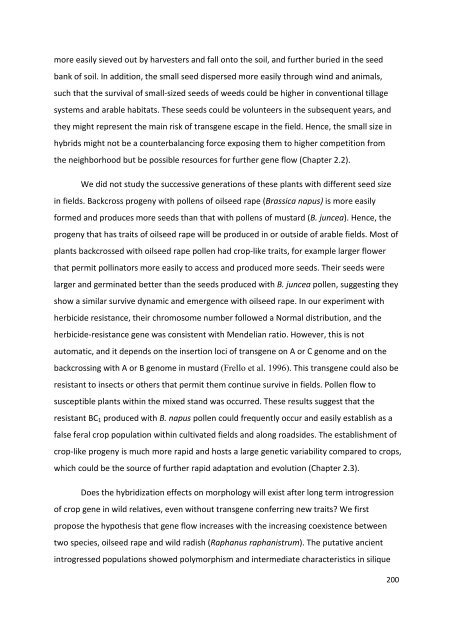UNIVERSITE DE BOURGOGNE THÈSE Yongbo LIU - Université de ...
UNIVERSITE DE BOURGOGNE THÈSE Yongbo LIU - Université de ...
UNIVERSITE DE BOURGOGNE THÈSE Yongbo LIU - Université de ...
You also want an ePaper? Increase the reach of your titles
YUMPU automatically turns print PDFs into web optimized ePapers that Google loves.
more easily sieved out by harvesters and fall onto the soil, and further buried in the seed<br />
bank of soil. In addition, the small seed dispersed more easily through wind and animals,<br />
such that the survival of small-sized seeds of weeds could be higher in conventional tillage<br />
systems and arable habitats. These seeds could be volunteers in the subsequent years, and<br />
they might represent the main risk of transgene escape in the field. Hence, the small size in<br />
hybrids might not be a counterbalancing force exposing them to higher competition from<br />
the neighborhood but be possible resources for further gene flow (Chapter 2.2).<br />
We did not study the successive generations of these plants with different seed size<br />
in fields. Backcross progeny with pollens of oilseed rape (Brassica napus) is more easily<br />
formed and produces more seeds than that with pollens of mustard (B. juncea). Hence, the<br />
progeny that has traits of oilseed rape will be produced in or outsi<strong>de</strong> of arable fields. Most of<br />
plants backcrossed with oilseed rape pollen had crop-like traits, for example larger flower<br />
that permit pollinators more easily to access and produced more seeds. Their seeds were<br />
larger and germinated better than the seeds produced with B. juncea pollen, suggesting they<br />
show a similar survive dynamic and emergence with oilseed rape. In our experiment with<br />
herbici<strong>de</strong> resistance, their chromosome number followed a Normal distribution, and the<br />
herbici<strong>de</strong>-resistance gene was consistent with Men<strong>de</strong>lian ratio. However, this is not<br />
automatic, and it <strong>de</strong>pends on the insertion loci of transgene on A or C genome and on the<br />
backcrossing with A or B genome in mustard (Frello et al. 1996). This transgene could also be<br />
resistant to insects or others that permit them continue survive in fields. Pollen flow to<br />
susceptible plants within the mixed stand was occurred. These results suggest that the<br />
resistant BC1 produced with B. napus pollen could frequently occur and easily establish as a<br />
false feral crop population within cultivated fields and along roadsi<strong>de</strong>s. The establishment of<br />
crop-like progeny is much more rapid and hosts a large genetic variability compared to crops,<br />
which could be the source of further rapid adaptation and evolution (Chapter 2.3).<br />
Does the hybridization effects on morphology will exist after long term introgression<br />
of crop gene in wild relatives, even without transgene conferring new traits? We first<br />
propose the hypothesis that gene flow increases with the increasing coexistence between<br />
two species, oilseed rape and wild radish (Raphanus raphanistrum). The putative ancient<br />
introgressed populations showed polymorphism and intermediate characteristics in silique<br />
200
















